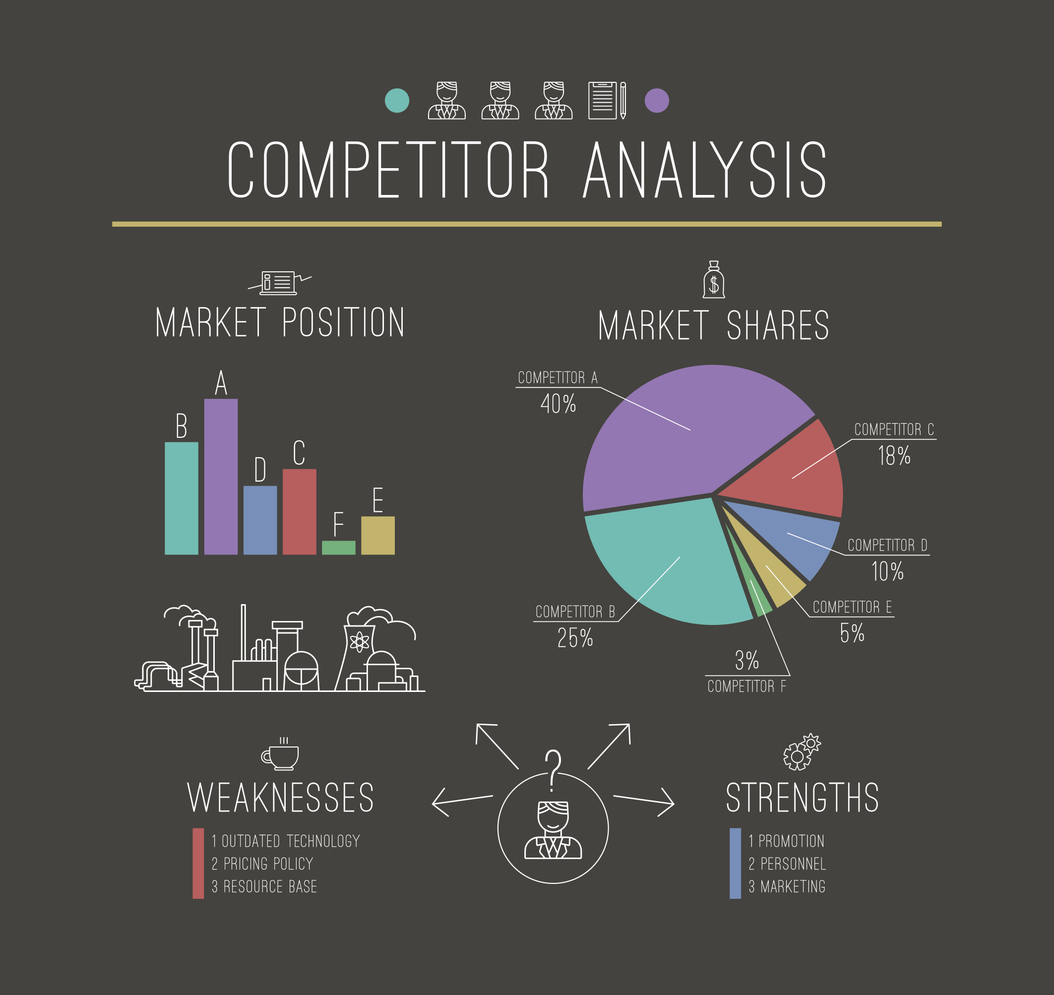Understanding your competition is not just an advantage—it's a necessity. Enter the competitive analysis matrix, a powerful tool that can uncover hidden opportunities and reveal potential threats lurking in your industry landscape. Whether you're a burgeoning startup or a seasoned enterprise, mastering this matrix will empower you to strategize with precision and outmaneuver your competitors. In this comprehensive guide, we'll walk you through the process of creating a competitive analysis matrix and how to do competitor benchmarking effectively, setting the stage for enhanced online visibility and success.

Deep Dive into the Competitive Analysis Matrix and Competitor Benchmarking
Understanding the competitive landscape is crucial for any business striving for market dominance. The competitive analysis matrix and competitor benchmarking are two pivotal tools that equip businesses with the insights needed to outperform rivals. Let’s explore these concepts in greater detail, emphasizing their importance in strategic business planning.
The Essence of the Competitive Analysis Matrix
The competitive analysis matrix is more than a tool; it's a strategic framework that helps businesses navigate the complex landscape of competition. It enables an in-depth evaluation of competitors' positioning, offerings, and strategies, providing a 360-degree view of the market dynamics. By analyzing key factors such as product features, market share, pricing strategies, and customer service, businesses can pinpoint their competitive edge and areas requiring improvement.

Key Factors Explained
- Product Features: A thorough analysis of competitors’ products can reveal unmet needs in the market, driving innovation and differentiation.
- Market Share: Understanding the distribution of market share sheds light on competitive dynamics and the potential for market entry or expansion.
- Pricing Strategies: Insight into how competitors price their offerings can guide businesses in crafting competitive pricing strategies that attract price-sensitive customers without compromising profit margins.
- Customer Service: Evaluating competitors' customer service standards sets benchmarks, aiming to exceed these to enhance customer loyalty and satisfaction.

Leveraging the Matrix for Online Presence
In the digital age, an optimized online presence is vital. The competitive analysis matrix directly informs strategies across multiple domains essential for digital success:
- Web Development: Insights into competitors’ web designs and functionalities can inspire improvements in your site, making it more user-friendly and engaging.
- SEO Strategies: Understanding competitors’ SEO tactics helps refine your approach to improve search engine rankings and visibility.
- Content Creation: Analyzing the content strategies of competitors can guide the development of compelling content that resonates with your target audience, driving traffic and engagement.
- Online Advertising: Insights into successful advertising strategies on platforms like Google Ads and social media can inform your campaigns, ensuring efficient use of budget for maximum impact.
Implementing Insights for Competitive Advantage
The ultimate goal of utilizing a competitive analysis matrix is to harness insights for strategic advantage. This might involve enhancing product offerings, revising pricing strategies, elevating customer service, and optimizing digital presence. Each of these initiatives contributes to a robust strategy that not only matches but exceeds competitor offerings, securing a dominant position in the market.
How to do Competitor Benchmarking
Competitor benchmarking complements the competitive analysis matrix by offering a methodical approach to measuring your business’s performance against industry standards and competitors.

Identifying Competitors
The foundation of effective benchmarking is the accurate identification of both direct and indirect competitors. Tools like SEMrush and Google Analytics provide a wealth of data on competitors’ online strategies, including insights into their SEO tactics, advertising campaigns, and targeted keywords.
Insights from Benchmarking
Competitor benchmarking goes beyond mere comparison; it’s about understanding the strategic moves of competitors and the rationale behind their success or failure. This understanding informs strategic decisions, guiding businesses in refining their approaches to marketing, product development, customer service, and overall online presence.
Choosing Key Metrics
Selecting the right metrics is crucial for effective benchmarking. These metrics should align with your business goals and provide insights into areas that significantly impact your performance. Key metrics often include:
- Website Traffic: The number of visitors to your and your competitors’ websites.
- Conversion Rate: The percentage of website visitors who take a desired action, such as making a purchase.
- Social Media Engagement: Interactions on social media platforms that indicate how actively engaged the audience is with the content.
- Customer Satisfaction Scores: Measures of how satisfied customers are with the product or service, often obtained through surveys and feedback.
Collect Data
Gathering data is the next step, involving a variety of tools and methods. Online tools like Alexa and SimilarWeb can offer insights into web traffic and user engagement. Surveys and direct customer feedback provide qualitative data on customer satisfaction and perceptions of your brand versus competitors. Additionally, analyzing social media can reveal engagement levels and audience sentiment.
Analyze and Interpret
With the data collected, the analysis phase helps in understanding where your business stands relative to competitors. This involves:
- Trend Analysis: Identifying patterns over time, such as growth in social media followers.
- Strengths and Weaknesses: Assessing what competitors do well and where they fall short, offering insight into potential areas for your business to exploit.
- Opportunities for Improvement: Highlighting areas where your business can enhance its offerings or operations to gain a competitive edge.
Implement Strategies
The final step is to take actionable steps based on the insights gained. This could involve:
- Improving Product Features: Based on competitor product analysis, enhancing your product to offer something unique.
- Optimizing Pricing Strategy: Adjusting prices to offer better value based on competitors’ pricing.
- Enhancing Customer Service: Implementing best practices in customer service identified through benchmarking to improve customer satisfaction.
- Refining Online Presence: Leveraging SEO and content strategies that have proven successful for competitors to improve your online visibility and engagement.
Competitor benchmarking is a dynamic process that requires ongoing attention to remain effective. By continuously monitoring the competitive landscape and adapting strategies accordingly, businesses can maintain a competitive edge. The goal is not merely to emulate what competitors are doing but to surpass them by leveraging unique strengths and opportunities identified through benchmarking.

Tailoring the Matrix to Various Businesses
Whether you're a dealership owner seeking to outshine local competitors or a marketing director of a multinational looking to dominate the global market, the competitive analysis matrix can be tailored to your specific needs. E-commerce companies can focus on metrics like website load time and user experience, while B2B clients might prioritize service customization and client support.
The synergy between the competitive analysis matrix and competitor benchmarking offers a comprehensive view of the competitive landscape. These tools are indispensable for businesses aiming to navigate the complexities of market competition, driving strategic decisions that lead to sustained growth and market leadership. By meticulously analyzing and implementing the insights gained from these frameworks, businesses can not only anticipate the moves of their competitors but also stay two steps ahead, ensuring their market dominance.
THAT Agency: Your Partner in Digital Success
At THAT Agency, we understand the pivotal role of competitive analysis in achieving digital marketing success. Our suite of services, from bespoke web design to targeted online advertising, is crafted to meet the unique needs of each client. By partnering with us, you gain access to expert insights and strategies that not only position you ahead of your competitors but also drive tangible growth in web traffic and revenue.
Ready to outpace your competitors and elevate your online presence? Let THAT Agency be your guide. Our comprehensive digital solutions are designed to uncover the potential of your business and propel it to new heights. Contact us today for more information and begin your journey to digital excellence.
Unlock Your Competitive Edge
Ready to outpace the competition? Grab your free copy of our Competitive Analysis Framework today. It's packed with insights and strategies to help you understand your market better and position your business for success. Don't miss out—download now and start shaping your competitive edge!





